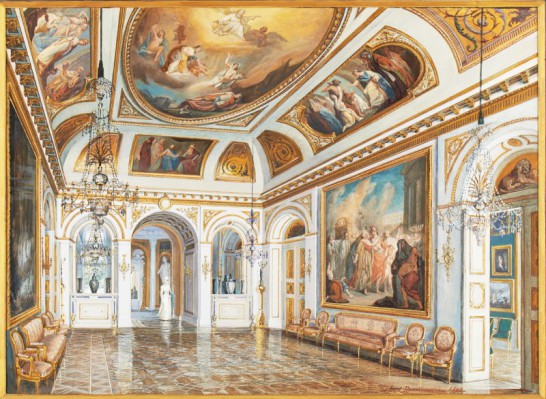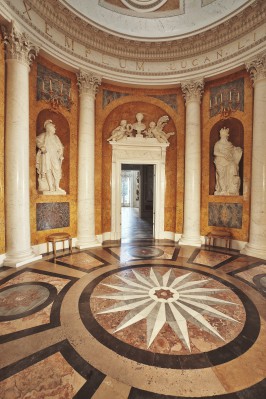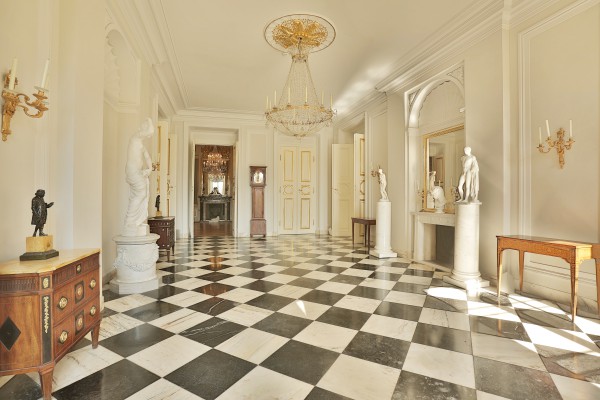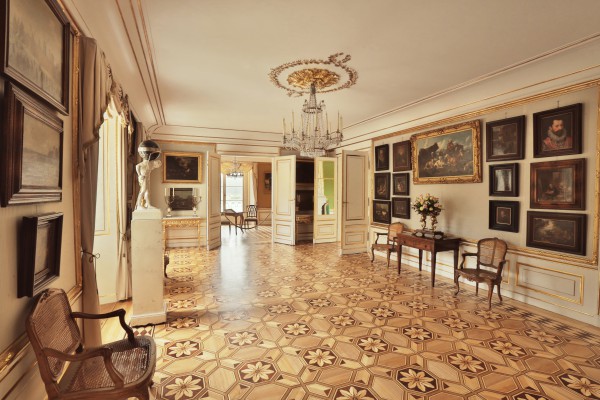
The Ballroom
The expansion of the rural villa of Stanisław August and changes in its appearance brought about the need for new rooms and premises, which would satisfy the demands of a larger number of guests often invited by the King. It was necessary to include a Ballroom – an indispensable element of every palace, where the guests could spend time during celebrations. The room was added in 1788 to the former Baths on the west side, and the works were executed according to the design by the Royal architect Johann Christian Kamsetzer. It is the most spacious room in the Palace. It is rectangular in shape and positioned along the north-south axis. It is characterized by a simple composition, harmony, and a light colour palette, which is further emphasised by the large amount of light entering through the tall balcony doors. The Classicist style visibly dominates the interior, which, nonetheless does includes late-Baroque items. Architectural decorations, sculptures, and paintings allude to well-known Ancient and Renaissance era patterns, such as the Raphael Loggias from the Papal Palace in the Vatican City. White walls and gildings allude to Louis XVI’s Versailles.
The construction of the Ballroom was completed in 1793. Its main decorative elements are two Ionic porticos made of white marble, while statues brought from Rome in the same year stand in the niches. The porticos form monumental frames for the fireplaces. In the southern niche, the sculpture Farnese Hercules is embedded. It is a copy of the Ancient work by the Roman artist Giuseppe Angelini. Hercules is portrayed as resting after a fight. He stands on a board supported by mythical characters. The first is Chiron – lethally wounded in the knee – one of the Centaurs, Hercules’ foes. The other is the three-headed dog in chains – Cerberus – defeated by the mythical hero by being brought out from Hades. On the other side of the room – in a niche in front of the fireplace, stands the Apollo Belvedere statue made in Rome by Antonio d’Este, on the basis of the Ancient model. It is positioned on a board supported by the sculpture of King Midas with donkeys’ ears and one of Satyr Marsyas bound. According to the mythology, the two were punished by Apollo for disputing his mastery of the lyre. The objects surrounding the fireplaces project Stanisław August’s vision of the ideal rule. Such rule was to come after overcoming all adversities faced by the King during his reign. It was imagined to be peaceful (symbolized by Hercules), and open to the development of arts and sciences (symbolized by Apollo).
The painted decoration of the walls is also an important element of the Ballroom symbolic design. It comprises rectangular wall panels filled with grotesques painted by Jan Bogumił Plersch in 1793. These depictions conveyed specific content alluding to the political reality of the time. Their creation should primarily be associated with the proceedings of the Great Sejm (1788-1792) and the adoption of the Constitution of May 3, 1791. The intended result of those events was to introduce a new, better order in the Republic, and bring about a so-called “golden age”, which is alluded to by the characters of the grotesques. These paintings represented also philosophical and existential ideas, reflecting the King’s interests. Here, we can see a personification of the Four Elements, Times of the Day, Seasons, and the Zodiac Signs, as well as mythological Parcae – spinning the thread of human life. Cronos-Saturn – seen above the clock – is the equivalent of the Christian Providence, in whose protection Stanisław August believed. The Pagan Lord of Time is the guarantor of the harmony expressed in the World Room.



















